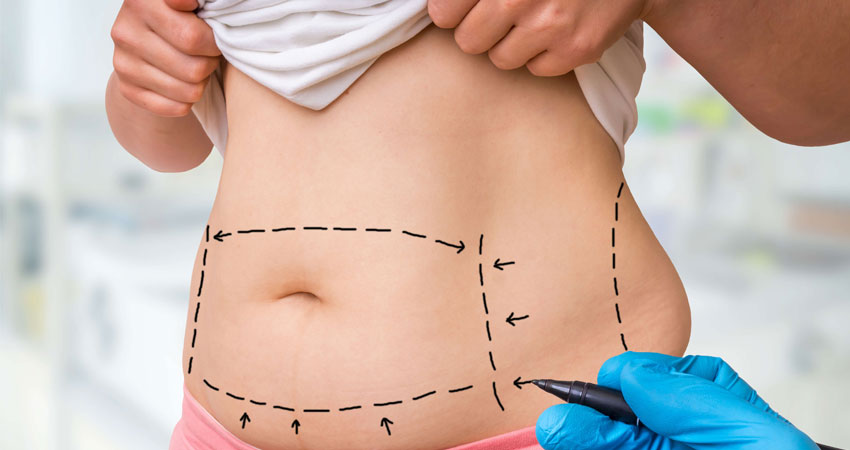
Abdominoplasty (Tummy Tuck)
This is also called an abdominal reduction or tummy tuck. In this procedure excess skin and fat from the abdomen can be removed, abdominal contours and scars improved, and the muscles tightened. With women the problem is usually caused by pregnancy, but is greatly aggravated by weight loss. The muscles of the abdominal wall may be weakened by pregnancy and actually pulled apart in the middle (divarication of recti). Men are similarly affected by weight loss.
The Operation
The Standard Abdominoplasty
The excess skin and fat of the abdominal wall between the pubic area and the umbilicus (navel) is removed leaving the umbilicus in place. The skin of the abdominal wall at the level of the umbilicus is then drawn down to suture it to at the pubic level. The patient is left with a long, usually curved scar across the lower part of the abdominal wall at the level of the pubic hair. There is also a scar around the umbilicus. Any looseness of the muscles of the abdominal wall or hernia is repaired at the same time Liposuction may be carried out during this procedure to thin the abdominal wall, or as a separate procedure either before or after the abdominoplasty.
Mini Abdominoplasty
In the Mini Abdominoplasty surplus skin below the umbilicus is removed leaving a low abdominal scar at the level of the pubic hair. The umbilicus is not disturbed but liposuction is usually carried out at the same time to reduce the thickness of fat in the abdominal wall and any laxity or hernia of the lower abdominal wall is repaired at the same time.
Extended Abdominoplasty
In the Extended Abdominoplasty surplus skin and fat of the loins and back are also removed so that the scar extends around the flanks onto the lower back.
Limitations
The skin is usually tightened downwards and this does not tighten the waist. If this is desired then one can consider removing skin vertically, but one should bear in mind that vertical scars of the abdomen are less good.
The tissue of the abdominal wall is generally fatter than the groin and if liposuction is not carried out a fatty bulge may remain above the scar.
The beneficial effects of the operation will last well, however, the effects will be maintained better if the patient keeps exercising the muscles and keeps the weight steady. A further pregnancy will of course stretch the skin again, although probably not to the same degree.
Risks
The standard abdominoplasty is a major surgical procedure requiring two to four Days of hospitalisation. Drains are removed when they stop draining blood and serum a few days after the procedure. This fluid can reaccumulate after the drains are removed requiring drainage or aspiration. Healing can be slow particularly in the tighter central part of the wound and sometimes dressings are needed for a few weeks. This is more common in patients who are overweight and who smoke.
The patient is left with noticeable scars. The main scar runs transversely across the lower part of the abdomen and in a standard abdominal reduction there will be a scar around the umbilicus. There is numbness in the lower part of the abdominal wall after surgery this is usually temporary but could be permanent. Swelling above the scar is usually present due to a collection of tissue fluid which normally drains to the groin. This swelling or oedema settles within a few months.
Secondary procedures are sometimes carried out to tidy up the results and will involve scar revision and limited liposuction. Deep vein thrombosis and pulmonary embolus are rare complications of any operation including this one.
Before The Surgery
If you are overweight you would be well advised to diet as best results are obtained in people who are the correct weight for their height. If you are taking the contraceptive pill you should stop doing so for six weeks before surgery and use an alternative method in order to reduce the risk of thrombosis. If you smoke there is a greater risk of chest infection and in particular healing of the abdominal wound is less good.
After The Surgery
You will need to be in hospital for one to four days. You are likely to have drainage tubes coming out of each side of the lower abdomen which are there to drain any collection of blood or serum. You can expect some moderately severe pain for which you will be given pain killing tablets or injections. You will be asked to keep your knees and hips bent to take the strain off your stitches.
Over activity in the early days reduces healing and increases fluid accumulation. Light activities are comfortable in 10 to 20 days. Sports will not be possible for about 6 weeks particularly when the muscles have been strengthened with sutures. A corset is usually helpful to reduce the swelling and improve comfort in the first month.
 WhatsApp
WhatsApp